
 Jordan Jacklin
The Hockey Writers
Jordan Jacklin
The Hockey Writers
52
Reads
0
Comments
Buffalo Sabres’ Decade of Disappointment
It is the same story, but a different year when it comes to describing the Buffalo Sabres. The team has not qualified for the playoffs since the 2010-11 season, and they are poised to miss again. When this streak started, Jason Pominville was still months away from being named the 13th captain in franchise history. Ville Leino had yet to sign with the team after a 53-point season with the Philadelphia Flyers. This decade that has been full of disappointment and misery is the opposite of what happened in the preview 10-year span, which saw the Sabres make the Eastern Conference Final twice.
I will review what has gone wrong these past 10 years, the storylines that emerged as the seasons progressed, and how the team failed to get better over this span.
2011-12: Just Missing the Playoffs
This season can be known as the year the Sabres nearly made the postseason but just fell short. Pominville had scored 30 goals and 73 points in his first season wearing the captaincy, and third-year Tyler Ennis started to break through as a scoring threat for this team. Ryan Miller and Jonas Enroth each had a .916 and .917 save percentage, respectively, and gave this team a chance to win in every game. Christian Ehrhoff as the best defenseman and Derick Roy as the first-line center factored into its disappointing season.
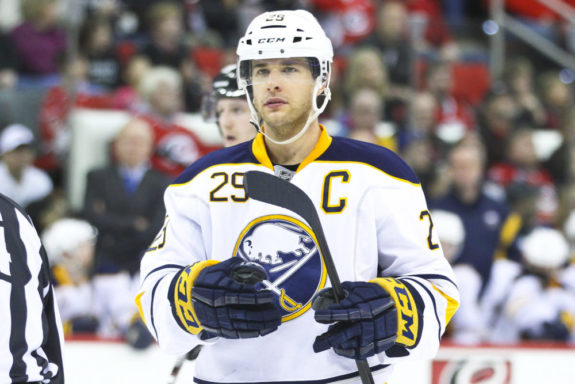
When looking at the trades made throughout this season, the biggest two were acquiring Cody Hodgson from the Vancouver Canucks for Zack Kassian and trading Paul Gaudstad for a first-round pick from the Nashville Predators. It was clear that the team was trying to get younger and stock up on draft capital and that making the playoffs would not be a guarantee.
Overall, the team finished with a record of 39-32-11, and they just fell short of qualifying for the postseason. The Sabres had two first-round selections in the 2012 NHL Draft. With the 12th-overall selection, they picked Mikhail Grigorenko, who currently plays for the Columbus Blue Jackets. At 14th overall, they selected Zemgus Girgensons, who is still on the team. Both were selected too high for the caliber of player that they are today. Linus Ullmark was a steal at 163rd overall.
2012-13: This Team Needs Direction
In the offseason, the Sabres traded away Roy to the Dallas Stars and acquired Steve Ott and Adam Parody. (from ‘Sabres trade Derek Roy to Stars for Steve Ott, Adam Pardy,’ National Post – 07/02/2012) That trade didn’t exactly work that well for both teams, as you will find out below. This was the shortened season, which saw the team play 48 games. It was clear that the team was heading towards a rebuild, but they weren’t bad enough to be the league’s worst team.
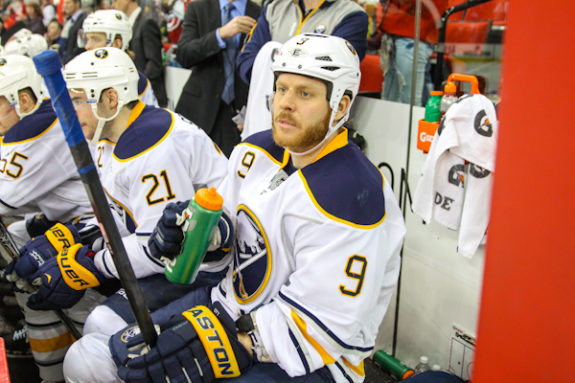
Over the course of the year, the Sabres acquired seven draft picks to see the team part ways with numerous players. The most notable was Pominville, as he was traded to Minnesota along with a 2014 fourth-round pick, and the Wild gave Matt Hacket, Johan Larsson, a 2013 first-round pick, and a 2014 second-round pick. In hindsight, that was a solid trade for the Sabres, as Pominville would decline over the next several seasons.
Related: Buffalo Sabres Report Card Through First Half of Season
The team finished the season with a record of 21-21-6 and clearly missed the playoffs this time. They had the ninth-overall selection in the 2013 NHL Draft and used it to select Rasmus Ristolainen. Although he is a controversial player among the fanbase, there aren’t many players that I would have taken over him, besides Josh Morrissey and Bo Horvat.
2013-14: The First Tank Season
The tank had officially started, and all eyes were on the prospects available for the coming draft. Aaron Ekblad was the favorite, but players such as Sam Reinhart, Sam Bennett, and Leon Draisaitl would possibly overthrow him. Cody Hodgson, who hasn’t played in the NHL since 2016, led this team in scoring with 20 goals and 44 points. Their goaltending was the only reason why they didn’t lose in every single matchup.
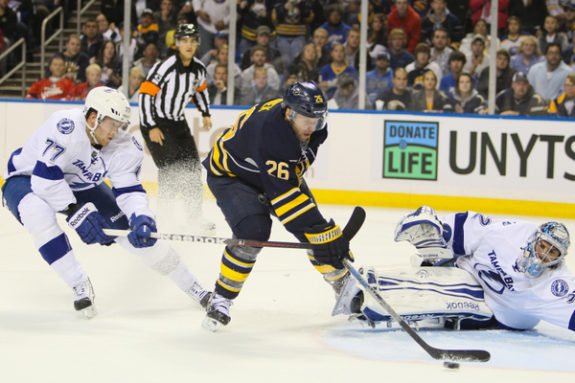
To have the best possible chance at acquiring any of those players, the team had to part ways with several key members on the roster. Ryan Miller, Thomas Vanek, and Jaroslav Halak were all moved at the trade deadline, and this team went from bad to awful. The team finished with a record of 21-51-10 after 82 games.
The team ended up with the second-overall selection in the 2014 NHL Draft and used it to Sam Reinhart. He has become a great two-way, second-line winger, and although Draisaitl would have been the better pick in hindsight, Reinhart is no slouch himself. Victor Olofsson went in the seventh round and has provided amazing value for what was expected of him, as he’s become a threat to score 30 goals consistently for years to come.
2014-15: We Must Get McDavid at All Costs
If there was ever a season to tank, it was this one. Everybody in the hockey world knew who the first-overall pick would be, and that was Connor McDavid. The team was clearly awful, as they had been trading roster players for draft capital over the last couple of seasons. It was quite clear what they were doing. This was also the famous season where Michal Neuvirth played only two games for the team, won both of them, and they traded him because he wasn’t going to help them lose.
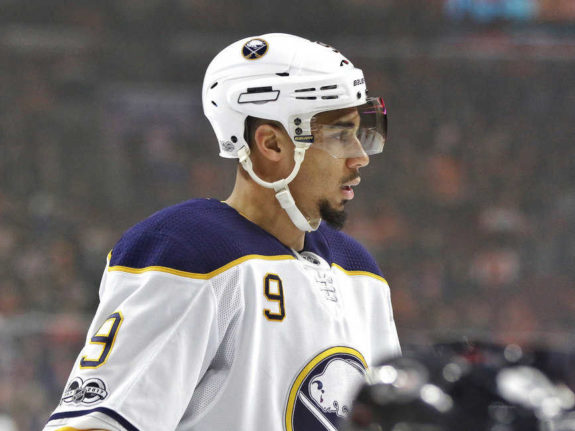
The Sabres acquired Evander Kane, Zach Bogosian, and Jason Kardorf from the Winnipeg Jets in exchange for Brendan Lemieux, Joel Armia, Drew Stafford, Tyler Myers, and a 2015 first-round pick (via St. Louis). This was a blockbuster trade at the time, as Lemieux was seen as one of the team’s best prospects, and Myers was a part of their top two defensive pairings. Ultimately, Kane would be a scoring threat during his time here, and it was a good deal that benefitted both teams. The team finished with a record of 23-51-8.
Related: Sabres GM Kevyn Adams Predicts More Change After Krueger Firing
Then, the draft lottery came. This was the day that Sabres fans were looking forward to the most. The NHL’s Deputy Commissioner Bill Daly spins the white balls, and the first-overall selection ended up going to the Oilers. The team luckily had Jack Eichel as a consolation prize and found their first-line center, but the feeling of disappointment was quite evident in Tim Murray’s face.
2015-16: There Is Hope in Buffalo
Finally, there was some excitement surrounding this organization. It has been four years since the team last made the postseason, and their chances grew when they inserted Eichel into the lineup. As Kane scored 20 goals, the team was showing positive signs of growth, and Reinhart continued to grow with a 42-point season. As well, the team had acquired a player in the offseason that would be a game-changer.
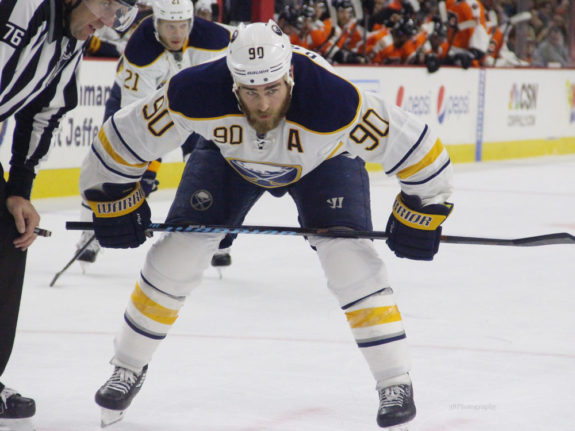
The Sabres acquired Ryan O’Reilly in that offseason, along with Jamie McGinn from the Colorado Avalanche. In return, the team gave up Nikita Zadorov, Grigorenko, J.T. Compher, and a 2015 second-round pick. They were clearly trying to add some capable scorers into a lineup that couldn’t score. O’Reilly put up 60 points in 71 games during this season, leading as the team’s first-line center.
Related: Buffalo Sabres Report Card Through First Half of Season
The team finished with a record of 35-36-11, accumulating 27 more points than the previous season. During the 2016 NHL Draft, the Sabres selected Alex Nylander with their eighth-overall pick. Only Rasmus Asplund remains with the organization, which shows how poorly the scouting department evaluated the players selected from the second to the seventh round.
2016-17: Some Assembly Required
This was a season filled with injuries for the team, as Eichel missed the first seven weeks after suffering a high-ankle sprain in practice. This was also Kyle Okposo’s first season as a Sabre, and he put up a respectable 45 points in 65 games. Although the playoffs were in reach during multiple points in the season, the team generated enough scoring throughout their lineup.
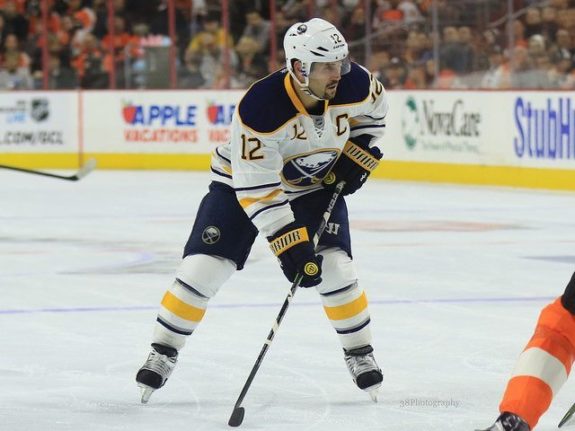
Leading up to the season, the Sabres had acquired Jimmy Vesey for a 2016 third-round pick from the Nashville Predators, as he was the biggest college free agent on the market. Ultimately, Buffalo couldn’t convince him to sign with the team, and he left for the New York Rangers. The only trade deadline acquisition for the team was Mat Bodie, and they moved Daniel Catenacci to the Rangers. The team would end up finishing with a record of 33-37-12, missing the playoffs by 17 points.
Looking back at the 2017 NHL Draft, the team had the eighth-overall selection for the second year in a row. With that pick, they selected Casey Mittelstadt, who is finally starting to look like a player. He had very high expectations, and it does not seem like he will ever live up to them, but he will be a solid middle-six player for years to come. Jacob Bryson, selected in the fourth round, has provided good value and looks like he can be a third-pairing defenseman.
2017-18: Fallin for Dahlin
The Sabres should have put a team by Eichel at this point, but they actually got worse. In the offseason, they re-acquired Pominville, as well as adding Marco Scandella and Nathan Beaulieu. This ended up being O’Reilly’s last season with the team, as he put up another 60-point season. He lost his love of the game, stating, “That’s how I kind of fell out of love with it, and I miss that. I want to get back to myself.” (Sabres’ Ryan O’Reilly says he lost the love of the game, lacked mental toughness,” The Buffalo News – 04/09/2018).
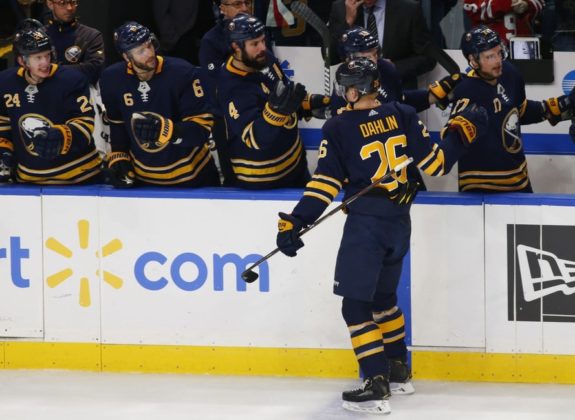
At the trade deadline, Kane was sent to the San Jose Sharks for a 2019 first-round pick, Daniel O’Regan, and a 2020 fourth-round pick. He was scoring at a 30-goal pace, but the team was clearly going to be one of the last-place teams, and they wanted the best chance to draft Swedish defenseman Rasmus Dahlin. That would end up being the case, as the Sabres finished with a record of 25-45-12, which put them eight points behind the next worse team.
After such a terrible season full of setbacks and heartaches, there was hope within the organization. The Sabres won the draft lottery and selected Dahlin with the first-overall pick in the 2019 NHL Draft. He has showcased his potential throughout his first three seasons, but there is a next level for him to reach. We’ll have to see if he can do it.
2018-19: This Team Is Unstoppable, Except They’re Not
The Sabres looked poised to make the postseason for the first time in eight seasons, as they went on a 10-game winning streak in November, making their record after 25 games an outstanding 17-6-2. (“Sabres ride longest winning streak of season into grueling stretch”, The Buffalo News – 11/15/2018) The key factor on why the team was outperforming expectations was Jeff Skinner, who the Sabres acquired from the Carolina Hurricanes in change for Cliff Pu, a 2019 second-round pick, and a 2020 third- and sixth-round pick. How could a season full of so many positives end up derailing so quickly?
The team went 16-33-8 in the remaining 57 games of the season, and once again, there was no depth scoring players like Vladimir Sobotka or Tage Thompson. In the previous offseason, Robin Lehner left the team, and it hurt them. He perennially put up around a .920 save percentage when he was here, and they couldn’t replace it. They signed Carter Hutton to a three-year contract, worth an average annual value of $2.75 million — he underperformed immediately and still is overpaid relative to his deal.
After everything went right, the true Sabres had awoken and that led to another season full of failures.
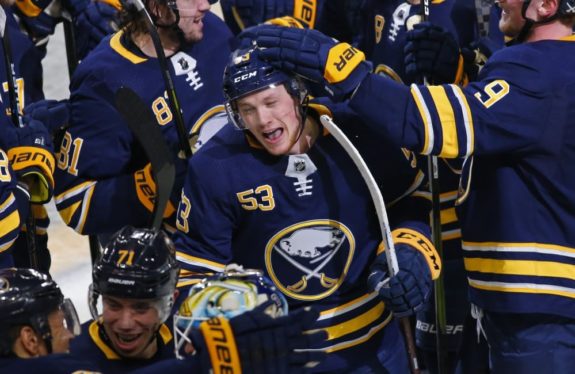
At the trade deadline, the team believed that they could still fight for a wildcard spot and acquired Brandon Montour from the Anaheim Ducks. In that deal, they sent prospect Brandon Guhle and a 2019 first-round pick (via San Jose), which clearly sent the message that losing was no longer acceptable. In the end, the team finished with a record of 33-39-10, missing the playoffs by 22 points.
Related: Sabres GM Kevyn Adams Predicts More Change After Krueger Firing
At the 2019 NHL Draft, the team had two first-round picks, as they acquired one in the O’Reilly trade. First, with the eighth-overall selection, they picked Dylan Cozens from the Western Hockey League. He is currently playing in his rookie season and looks to be a solid top-six option for years to come, and he can play center and wing. Ross Johnson was selected with the 31st pick and is a potential second-pairing defenseman based on his ceiling.
2019-20: Is This Finally the Year?
In the offseason leading up to the 2019-20 NHL season, the Sabres made deals to make their team better. They re-acquired Vesey and snagged Colin Miller for the blue line. They traded Nylander for Henri Jokiharju, which seemed very good at the time, but time will tell who the better player is. Although the on-paper roster looked promising, the Sabres could not make the postseason for the ninth year in a row. This was when the Eichel trade rumors started to gain speculation.
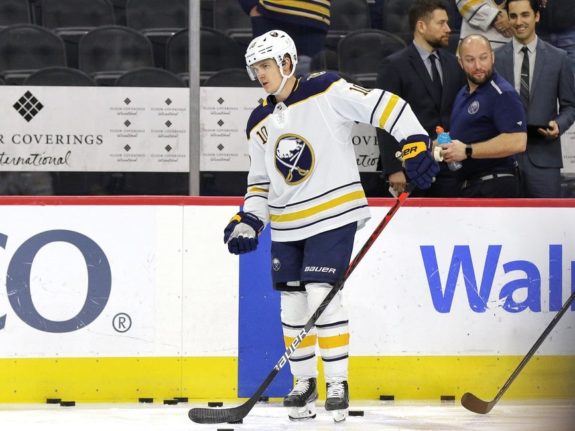
The trade deadline saw the team get bamboozled by the Canadiens, as they sent Scandella to Montreal for a 2020 fourth-round pick, and the Habs traded him a month later to St. Louis for a 2020 second- and fourth-round pick. They acquired Wayne Simmonds from the New Jersey Devils for a 2021 conditional fifth-round pick, as they wanted to paint the picture that they still cared. The biggest move was acquiring Dominik Kahun from the Pittsburgh Penguins for Conor Sheary and Evan Rodrigues, which was seen as a terrific deal at the time. Kahun was an upgrade over Sheary, and Rodrigues was bad in his role on the team’s bottom-six forward lines.
Related: NHL Rumors: Oilers, Stars, Senators, Sabres and Hall, More
The 2020 NHL Draft saw the team have the eighth-overall selection for the fourth time in five seasons, and with that pick, they selected Jack Quinn. Due to the pandemic, he has gotten the chance to be on the Sabres’ taxi squad and play with the Rochester Americans in the AHL. Although there were players in Marco Rossi and Cole Perfetti who were seen as better options, time will tell if that was a good selection.
2020-21: We Must Make the Playoffs
Finally, we have arrived at the current season. The Sabres just fired their head coach in Ralph Krueger, and the team is currently on a 13-game losing streak. They signed Taylor Hall in the offseason to a one-year deal in the hopes that he would excel on a line with Eichel, but that hasn’t worked out. Eric Staal was brought in to be a mentor on the second line. Skinner has played on the team’s third and fourth line for the entire season and is being paid an average annual value of $9 million for the next six seasons. Nothing has gone well in Buffalo.
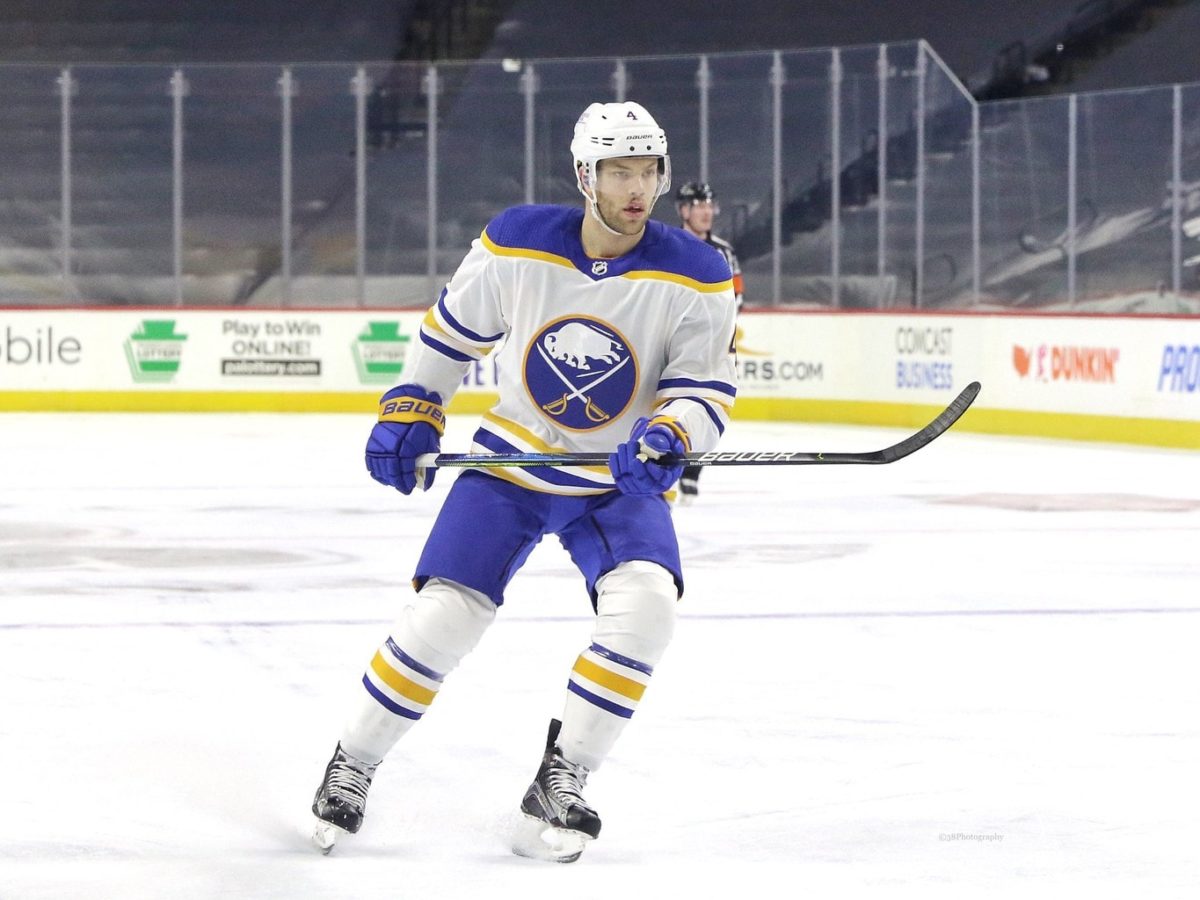
The trade deadline is on April 12, and names like Staal and Hall are likely to be moved if the team can find suitors for them. Eichel’s name is out there, and that is likely a deal made in the offseason. If that happens, the main takeaway will be that this is the most dysfunctional organization in pro sports. They have to reconcile the relationship with this player and build a future around him.
Regarding the upcoming draft in June, it has been learned that the Sabres are primarily relying on video scouting, and they do not employ scouts to cover the WHL, Finland, or Russia. How can anybody be hopeful that this team will become better in the future?
Overall, this past decade has been awful to witness in all aspects. From acquiring Pominville to trading away everybody to land McDavid, this organization is a tire fire. The good news is that they have set the bar so low that it will be almost impossible to regard it as worse for the next decade. Always look for the positives.
Popular Articles

















































 Canucks Vancouver
Canucks Vancouver Sharks San Jose
Sharks San Jose Flames Calgary
Flames Calgary Avalanche Colorado
Avalanche Colorado Coyotes Arizona
Coyotes Arizona Golden Knights Vegas
Golden Knights Vegas Wild Minnesota
Wild Minnesota Red Wings Detroit
Red Wings Detroit Blues St. Louis
Blues St. Louis Blackhawks Chicago
Blackhawks Chicago Blue Jackets Columbus
Blue Jackets Columbus Hurricanes Carolina
Hurricanes Carolina Jets Winnipeg
Jets Winnipeg Predators Nashville
Predators Nashville Ducks Anaheim
Ducks Anaheim Oilers Edmonton
Oilers Edmonton Sabres Buffalo
Sabres Buffalo Rangers New York
Rangers New York Bruins Boston
Bruins Boston Panthers Florida
Panthers Florida Senators Ottawa
Senators Ottawa Lightning Tampa Bay
Lightning Tampa Bay Capitals Washington
Capitals Washington Islanders New York
Islanders New York Devils New Jersey
Devils New Jersey Maple Leafs Toronto
Maple Leafs Toronto Flyers Philadelphia
Flyers Philadelphia Penguins Pittsburgh
Penguins Pittsburgh Stars Dallas
Stars Dallas Kraken Seattle
Kraken Seattle Kings Los Angeles
Kings Los Angeles






